Analysis of Interoperability Issues in Healthcare (Nursing Assignment)
VerifiedAdded on 2023/06/04
|7
|1464
|228
Report
AI Summary
This nursing assignment report addresses the critical issue of interoperability within healthcare environments. It begins by defining the problem, highlighting the challenges of exchanging patient data between different Electronic Health Record (EHR) systems, leading to delays, confusion, and potential errors. The report analyzes the workflow to identify the root cause as a lack of spontaneous communication between healthcare organizations. The report then recommends a potential solution involving the implementation of application programming interfaces (APIs) and cloud computing to facilitate seamless data sharing. The recommendation is supported by evidence from scholarly sources demonstrating the effectiveness of these technologies in improving data exchange, reducing medication errors, and enhancing patient care. The report emphasizes the importance of interface compatibility, government frameworks, and incentives to address the interoperability challenges and improve healthcare delivery.
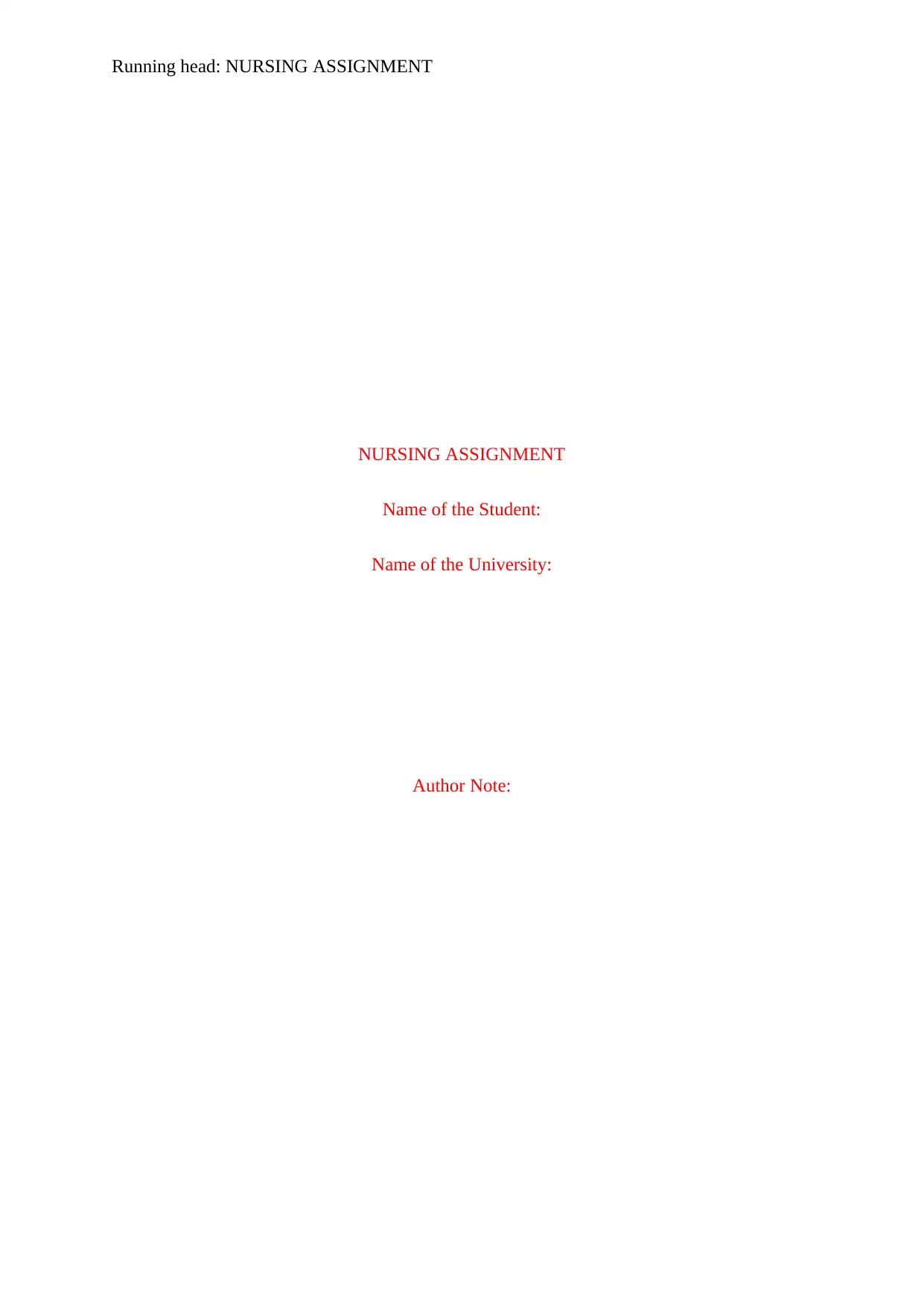
Running head: NURSING ASSIGNMENT
NURSING ASSIGNMENT
Name of the Student:
Name of the University:
Author Note:
NURSING ASSIGNMENT
Name of the Student:
Name of the University:
Author Note:
Paraphrase This Document
Need a fresh take? Get an instant paraphrase of this document with our AI Paraphraser
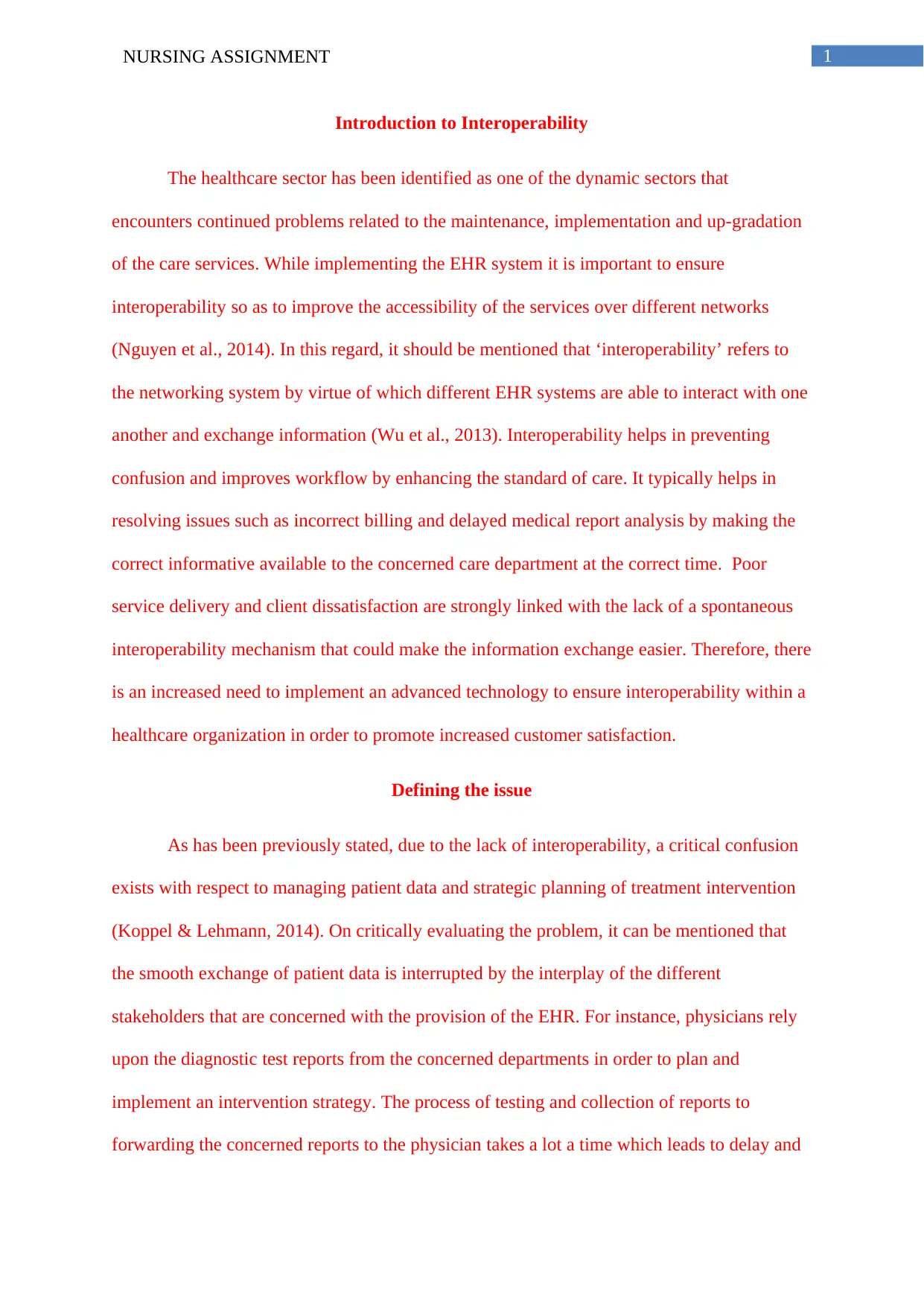
NURSING ASSIGNMENT 1
Introduction to Interoperability
The healthcare sector has been identified as one of the dynamic sectors that
encounters continued problems related to the maintenance, implementation and up-gradation
of the care services. While implementing the EHR system it is important to ensure
interoperability so as to improve the accessibility of the services over different networks
(Nguyen et al., 2014). In this regard, it should be mentioned that ‘interoperability’ refers to
the networking system by virtue of which different EHR systems are able to interact with one
another and exchange information (Wu et al., 2013). Interoperability helps in preventing
confusion and improves workflow by enhancing the standard of care. It typically helps in
resolving issues such as incorrect billing and delayed medical report analysis by making the
correct informative available to the concerned care department at the correct time. Poor
service delivery and client dissatisfaction are strongly linked with the lack of a spontaneous
interoperability mechanism that could make the information exchange easier. Therefore, there
is an increased need to implement an advanced technology to ensure interoperability within a
healthcare organization in order to promote increased customer satisfaction.
Defining the issue
As has been previously stated, due to the lack of interoperability, a critical confusion
exists with respect to managing patient data and strategic planning of treatment intervention
(Koppel & Lehmann, 2014). On critically evaluating the problem, it can be mentioned that
the smooth exchange of patient data is interrupted by the interplay of the different
stakeholders that are concerned with the provision of the EHR. For instance, physicians rely
upon the diagnostic test reports from the concerned departments in order to plan and
implement an intervention strategy. The process of testing and collection of reports to
forwarding the concerned reports to the physician takes a lot a time which leads to delay and
Introduction to Interoperability
The healthcare sector has been identified as one of the dynamic sectors that
encounters continued problems related to the maintenance, implementation and up-gradation
of the care services. While implementing the EHR system it is important to ensure
interoperability so as to improve the accessibility of the services over different networks
(Nguyen et al., 2014). In this regard, it should be mentioned that ‘interoperability’ refers to
the networking system by virtue of which different EHR systems are able to interact with one
another and exchange information (Wu et al., 2013). Interoperability helps in preventing
confusion and improves workflow by enhancing the standard of care. It typically helps in
resolving issues such as incorrect billing and delayed medical report analysis by making the
correct informative available to the concerned care department at the correct time. Poor
service delivery and client dissatisfaction are strongly linked with the lack of a spontaneous
interoperability mechanism that could make the information exchange easier. Therefore, there
is an increased need to implement an advanced technology to ensure interoperability within a
healthcare organization in order to promote increased customer satisfaction.
Defining the issue
As has been previously stated, due to the lack of interoperability, a critical confusion
exists with respect to managing patient data and strategic planning of treatment intervention
(Koppel & Lehmann, 2014). On critically evaluating the problem, it can be mentioned that
the smooth exchange of patient data is interrupted by the interplay of the different
stakeholders that are concerned with the provision of the EHR. For instance, physicians rely
upon the diagnostic test reports from the concerned departments in order to plan and
implement an intervention strategy. The process of testing and collection of reports to
forwarding the concerned reports to the physician takes a lot a time which leads to delay and
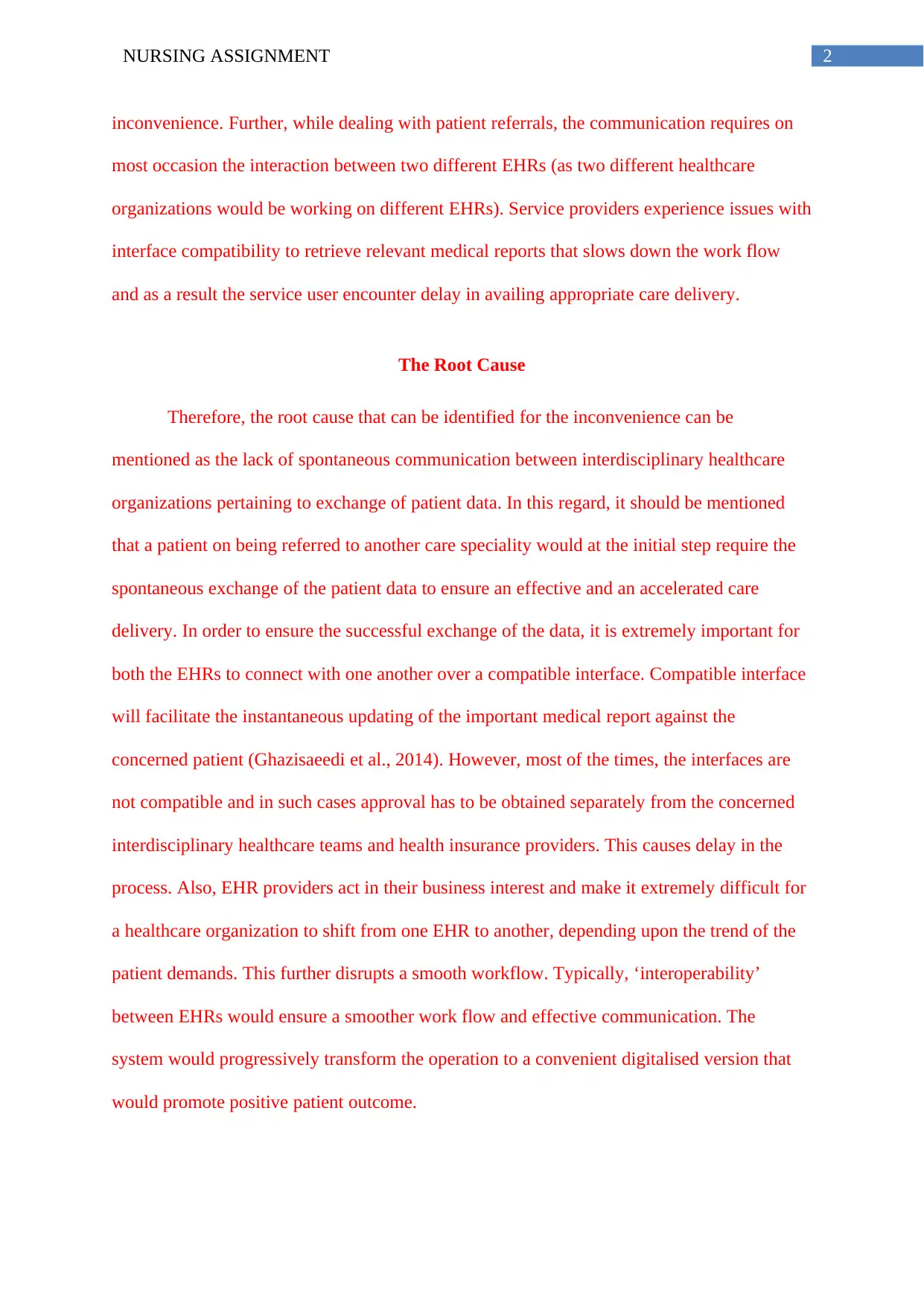
2NURSING ASSIGNMENT
inconvenience. Further, while dealing with patient referrals, the communication requires on
most occasion the interaction between two different EHRs (as two different healthcare
organizations would be working on different EHRs). Service providers experience issues with
interface compatibility to retrieve relevant medical reports that slows down the work flow
and as a result the service user encounter delay in availing appropriate care delivery.
The Root Cause
Therefore, the root cause that can be identified for the inconvenience can be
mentioned as the lack of spontaneous communication between interdisciplinary healthcare
organizations pertaining to exchange of patient data. In this regard, it should be mentioned
that a patient on being referred to another care speciality would at the initial step require the
spontaneous exchange of the patient data to ensure an effective and an accelerated care
delivery. In order to ensure the successful exchange of the data, it is extremely important for
both the EHRs to connect with one another over a compatible interface. Compatible interface
will facilitate the instantaneous updating of the important medical report against the
concerned patient (Ghazisaeedi et al., 2014). However, most of the times, the interfaces are
not compatible and in such cases approval has to be obtained separately from the concerned
interdisciplinary healthcare teams and health insurance providers. This causes delay in the
process. Also, EHR providers act in their business interest and make it extremely difficult for
a healthcare organization to shift from one EHR to another, depending upon the trend of the
patient demands. This further disrupts a smooth workflow. Typically, ‘interoperability’
between EHRs would ensure a smoother work flow and effective communication. The
system would progressively transform the operation to a convenient digitalised version that
would promote positive patient outcome.
inconvenience. Further, while dealing with patient referrals, the communication requires on
most occasion the interaction between two different EHRs (as two different healthcare
organizations would be working on different EHRs). Service providers experience issues with
interface compatibility to retrieve relevant medical reports that slows down the work flow
and as a result the service user encounter delay in availing appropriate care delivery.
The Root Cause
Therefore, the root cause that can be identified for the inconvenience can be
mentioned as the lack of spontaneous communication between interdisciplinary healthcare
organizations pertaining to exchange of patient data. In this regard, it should be mentioned
that a patient on being referred to another care speciality would at the initial step require the
spontaneous exchange of the patient data to ensure an effective and an accelerated care
delivery. In order to ensure the successful exchange of the data, it is extremely important for
both the EHRs to connect with one another over a compatible interface. Compatible interface
will facilitate the instantaneous updating of the important medical report against the
concerned patient (Ghazisaeedi et al., 2014). However, most of the times, the interfaces are
not compatible and in such cases approval has to be obtained separately from the concerned
interdisciplinary healthcare teams and health insurance providers. This causes delay in the
process. Also, EHR providers act in their business interest and make it extremely difficult for
a healthcare organization to shift from one EHR to another, depending upon the trend of the
patient demands. This further disrupts a smooth workflow. Typically, ‘interoperability’
between EHRs would ensure a smoother work flow and effective communication. The
system would progressively transform the operation to a convenient digitalised version that
would promote positive patient outcome.
⊘ This is a preview!⊘
Do you want full access?
Subscribe today to unlock all pages.

Trusted by 1+ million students worldwide
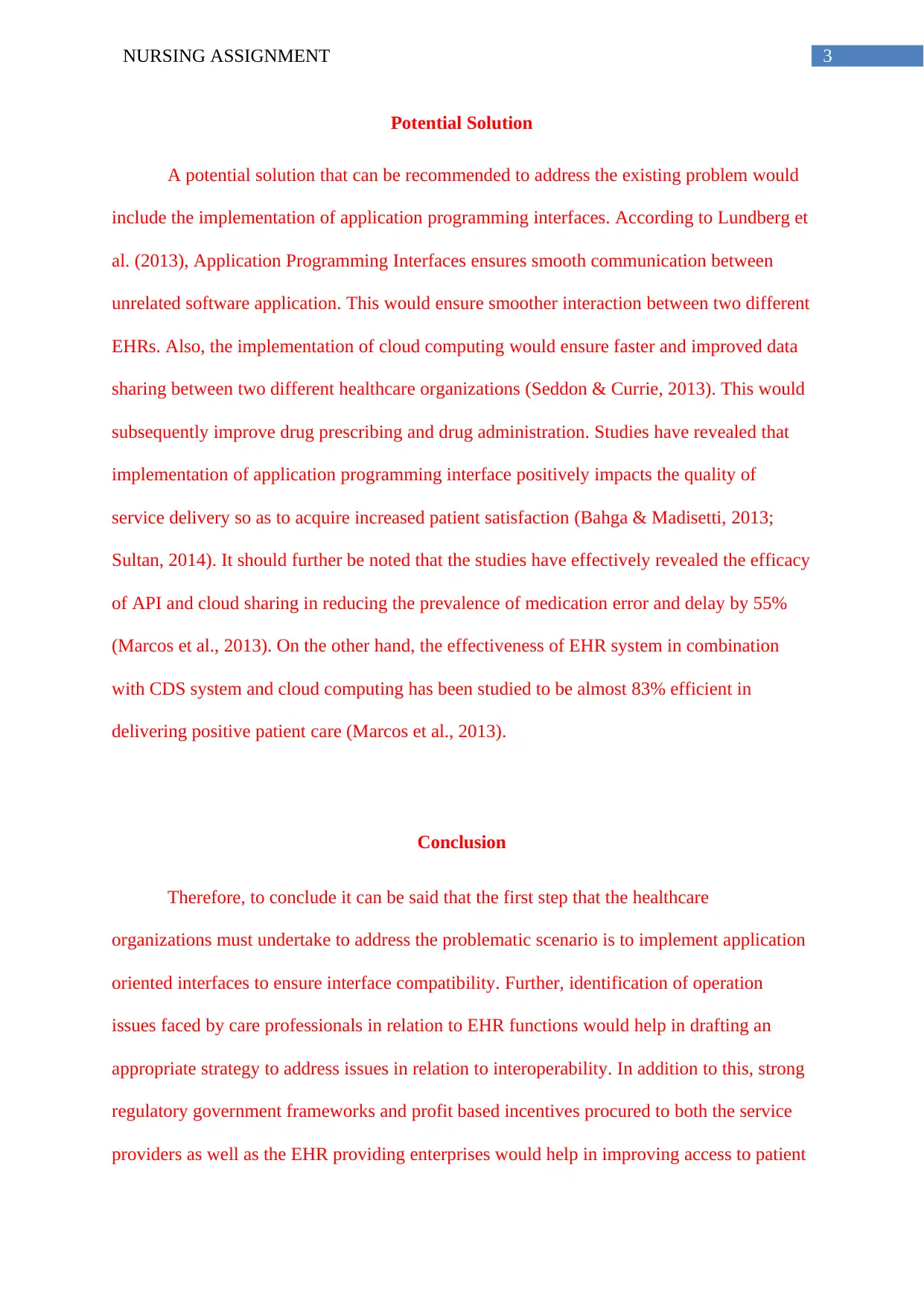
3NURSING ASSIGNMENT
Potential Solution
A potential solution that can be recommended to address the existing problem would
include the implementation of application programming interfaces. According to Lundberg et
al. (2013), Application Programming Interfaces ensures smooth communication between
unrelated software application. This would ensure smoother interaction between two different
EHRs. Also, the implementation of cloud computing would ensure faster and improved data
sharing between two different healthcare organizations (Seddon & Currie, 2013). This would
subsequently improve drug prescribing and drug administration. Studies have revealed that
implementation of application programming interface positively impacts the quality of
service delivery so as to acquire increased patient satisfaction (Bahga & Madisetti, 2013;
Sultan, 2014). It should further be noted that the studies have effectively revealed the efficacy
of API and cloud sharing in reducing the prevalence of medication error and delay by 55%
(Marcos et al., 2013). On the other hand, the effectiveness of EHR system in combination
with CDS system and cloud computing has been studied to be almost 83% efficient in
delivering positive patient care (Marcos et al., 2013).
Conclusion
Therefore, to conclude it can be said that the first step that the healthcare
organizations must undertake to address the problematic scenario is to implement application
oriented interfaces to ensure interface compatibility. Further, identification of operation
issues faced by care professionals in relation to EHR functions would help in drafting an
appropriate strategy to address issues in relation to interoperability. In addition to this, strong
regulatory government frameworks and profit based incentives procured to both the service
providers as well as the EHR providing enterprises would help in improving access to patient
Potential Solution
A potential solution that can be recommended to address the existing problem would
include the implementation of application programming interfaces. According to Lundberg et
al. (2013), Application Programming Interfaces ensures smooth communication between
unrelated software application. This would ensure smoother interaction between two different
EHRs. Also, the implementation of cloud computing would ensure faster and improved data
sharing between two different healthcare organizations (Seddon & Currie, 2013). This would
subsequently improve drug prescribing and drug administration. Studies have revealed that
implementation of application programming interface positively impacts the quality of
service delivery so as to acquire increased patient satisfaction (Bahga & Madisetti, 2013;
Sultan, 2014). It should further be noted that the studies have effectively revealed the efficacy
of API and cloud sharing in reducing the prevalence of medication error and delay by 55%
(Marcos et al., 2013). On the other hand, the effectiveness of EHR system in combination
with CDS system and cloud computing has been studied to be almost 83% efficient in
delivering positive patient care (Marcos et al., 2013).
Conclusion
Therefore, to conclude it can be said that the first step that the healthcare
organizations must undertake to address the problematic scenario is to implement application
oriented interfaces to ensure interface compatibility. Further, identification of operation
issues faced by care professionals in relation to EHR functions would help in drafting an
appropriate strategy to address issues in relation to interoperability. In addition to this, strong
regulatory government frameworks and profit based incentives procured to both the service
providers as well as the EHR providing enterprises would help in improving access to patient
Paraphrase This Document
Need a fresh take? Get an instant paraphrase of this document with our AI Paraphraser

4NURSING ASSIGNMENT
data. Also, it would require paying attention to the existing interoperability standards and
revising it so as to strengthen strategies to include and usenursing home data (outside data) in
hospitals. This would help in ensuring an effective care delivery.
data. Also, it would require paying attention to the existing interoperability standards and
revising it so as to strengthen strategies to include and usenursing home data (outside data) in
hospitals. This would help in ensuring an effective care delivery.
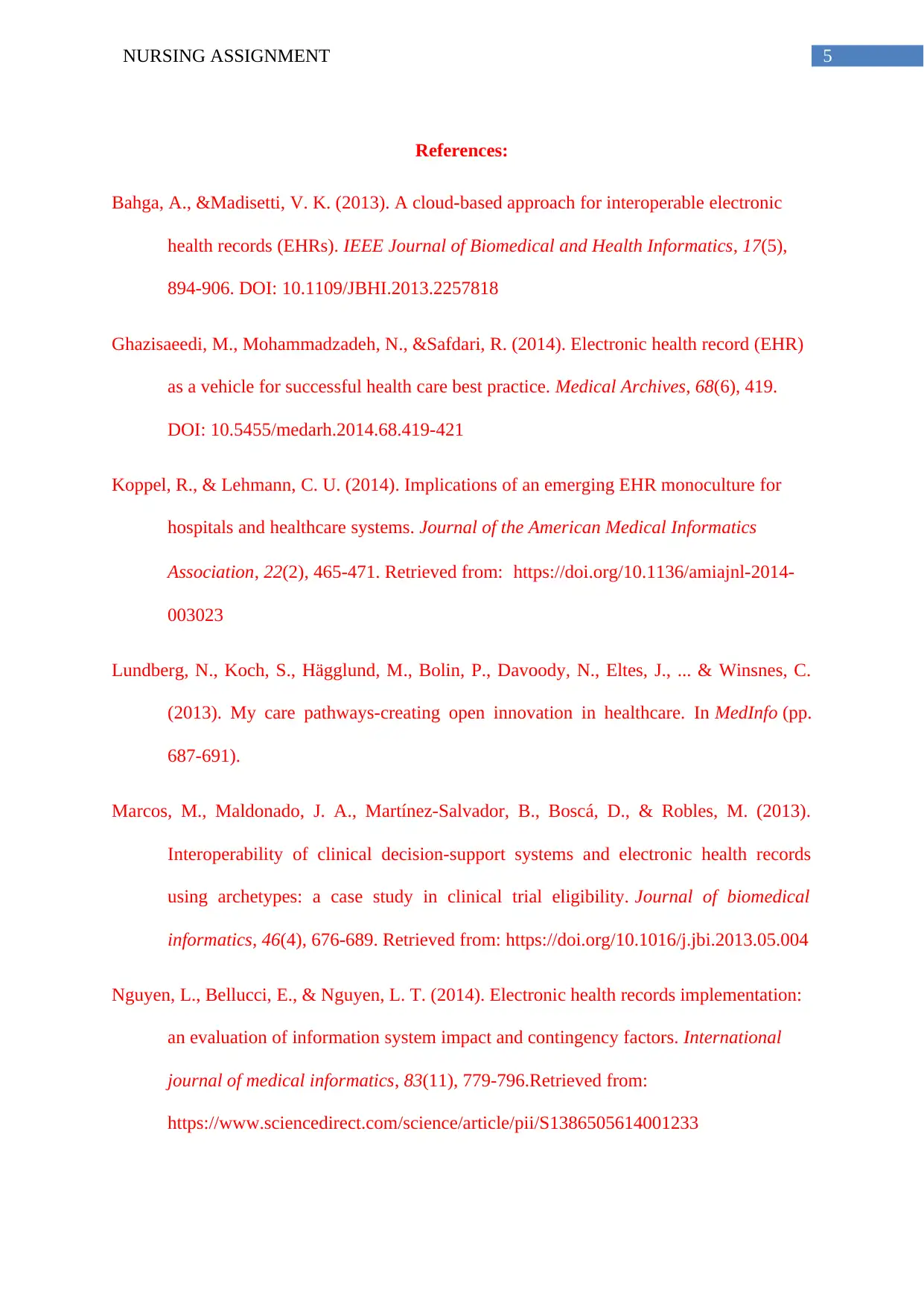
5NURSING ASSIGNMENT
References:
Bahga, A., &Madisetti, V. K. (2013). A cloud-based approach for interoperable electronic
health records (EHRs). IEEE Journal of Biomedical and Health Informatics, 17(5),
894-906. DOI: 10.1109/JBHI.2013.2257818
Ghazisaeedi, M., Mohammadzadeh, N., &Safdari, R. (2014). Electronic health record (EHR)
as a vehicle for successful health care best practice. Medical Archives, 68(6), 419.
DOI: 10.5455/medarh.2014.68.419-421
Koppel, R., & Lehmann, C. U. (2014). Implications of an emerging EHR monoculture for
hospitals and healthcare systems. Journal of the American Medical Informatics
Association, 22(2), 465-471. Retrieved from: https://doi.org/10.1136/amiajnl-2014-
003023
Lundberg, N., Koch, S., Hägglund, M., Bolin, P., Davoody, N., Eltes, J., ... & Winsnes, C.
(2013). My care pathways-creating open innovation in healthcare. In MedInfo (pp.
687-691).
Marcos, M., Maldonado, J. A., Martínez-Salvador, B., Boscá, D., & Robles, M. (2013).
Interoperability of clinical decision-support systems and electronic health records
using archetypes: a case study in clinical trial eligibility. Journal of biomedical
informatics, 46(4), 676-689. Retrieved from: https://doi.org/10.1016/j.jbi.2013.05.004
Nguyen, L., Bellucci, E., & Nguyen, L. T. (2014). Electronic health records implementation:
an evaluation of information system impact and contingency factors. International
journal of medical informatics, 83(11), 779-796.Retrieved from:
https://www.sciencedirect.com/science/article/pii/S1386505614001233
References:
Bahga, A., &Madisetti, V. K. (2013). A cloud-based approach for interoperable electronic
health records (EHRs). IEEE Journal of Biomedical and Health Informatics, 17(5),
894-906. DOI: 10.1109/JBHI.2013.2257818
Ghazisaeedi, M., Mohammadzadeh, N., &Safdari, R. (2014). Electronic health record (EHR)
as a vehicle for successful health care best practice. Medical Archives, 68(6), 419.
DOI: 10.5455/medarh.2014.68.419-421
Koppel, R., & Lehmann, C. U. (2014). Implications of an emerging EHR monoculture for
hospitals and healthcare systems. Journal of the American Medical Informatics
Association, 22(2), 465-471. Retrieved from: https://doi.org/10.1136/amiajnl-2014-
003023
Lundberg, N., Koch, S., Hägglund, M., Bolin, P., Davoody, N., Eltes, J., ... & Winsnes, C.
(2013). My care pathways-creating open innovation in healthcare. In MedInfo (pp.
687-691).
Marcos, M., Maldonado, J. A., Martínez-Salvador, B., Boscá, D., & Robles, M. (2013).
Interoperability of clinical decision-support systems and electronic health records
using archetypes: a case study in clinical trial eligibility. Journal of biomedical
informatics, 46(4), 676-689. Retrieved from: https://doi.org/10.1016/j.jbi.2013.05.004
Nguyen, L., Bellucci, E., & Nguyen, L. T. (2014). Electronic health records implementation:
an evaluation of information system impact and contingency factors. International
journal of medical informatics, 83(11), 779-796.Retrieved from:
https://www.sciencedirect.com/science/article/pii/S1386505614001233
⊘ This is a preview!⊘
Do you want full access?
Subscribe today to unlock all pages.

Trusted by 1+ million students worldwide

6NURSING ASSIGNMENT
Seddon, J. J., & Currie, W. L. (2013). Cloud computing and trans-border health data:
Unpacking US and EU healthcare regulation and compliance. Health policy and
technology, 2(4), 229-241.
Sultan, N. (2014). Making use of cloud computing for healthcare provision: Opportunities
and challenges. International Journal of Information Management, 34(2), 177-184.
Wu, A. W., Kharrazi, H., Boulware, L. E., & Snyder, C. F. (2013). Measure once, cut twice
—adding patient-reported outcome measures to the electronic health record for
comparative effectiveness research. Journal of clinical epidemiology, 66(8), S12-S20.
Retrieved from: https://doi.org/10.1016/j.jclinepi.2013.04.005
Seddon, J. J., & Currie, W. L. (2013). Cloud computing and trans-border health data:
Unpacking US and EU healthcare regulation and compliance. Health policy and
technology, 2(4), 229-241.
Sultan, N. (2014). Making use of cloud computing for healthcare provision: Opportunities
and challenges. International Journal of Information Management, 34(2), 177-184.
Wu, A. W., Kharrazi, H., Boulware, L. E., & Snyder, C. F. (2013). Measure once, cut twice
—adding patient-reported outcome measures to the electronic health record for
comparative effectiveness research. Journal of clinical epidemiology, 66(8), S12-S20.
Retrieved from: https://doi.org/10.1016/j.jclinepi.2013.04.005
1 out of 7
Related Documents
Your All-in-One AI-Powered Toolkit for Academic Success.
+13062052269
info@desklib.com
Available 24*7 on WhatsApp / Email
![[object Object]](/_next/static/media/star-bottom.7253800d.svg)
Unlock your academic potential
Copyright © 2020–2025 A2Z Services. All Rights Reserved. Developed and managed by ZUCOL.




